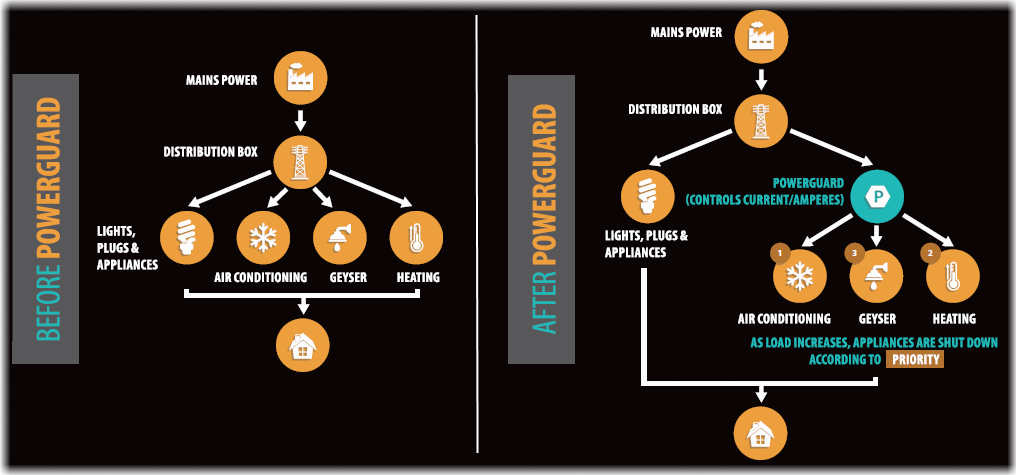PowerGuard Domestic Range
The PowerGuard® range of domestic peak power demand control systems were specifically designed for domestic environments, and can intelligently shift non-essential loads such as geysers, swimming pool pumps, air conditioners and underfloor heating, without any noticeable difference or inconvenience to the household.
Here is a diagram showing how PowerGuard®’s domestic range works.
Technical information – PowerGuard® domestic range
| 1 | PowerGuard® is designed to be installed between the household power distribution box and up to as many appliances as required (typically geysers, under-floor heating, air conditioning and pool pumps). The appliances can be connected into a hard-coded hierarchy specifying the relative importance of the different appliances (typically the main bathroom geyser would rank as the most important, followed by the second geyser etc.). This hierarchy will determine which appliance ranks highest for the receipt of electrical supply. |
| 2 | The PowerGuard® controller is then set to a maximum load level which can be determined either in relation to average consumption or to a lower level to reduce average consumption. Once switched on, PowerGuard® then constantly monitors the aggregate load of the entire household. |
| 3 | If, based on the load limit and PowerGuard®’s assessment of the current household load, there is sufficient spare capacity to switch on the connected appliances, PowerGuard® then follows the hierarchy in determining whether any of the connected appliances require electricity. |
| 4 | An important feature in minimising wear and tear as well as unwanted power surges, is that PowerGuard® first determines whether the appliance requires electricity before switching it on. |
| 5 | Once switched on, the appliance is allowed to draw electricity. Should the appliance require electricity for only a short period (e.g. geyser already hot), PowerGuard® will then test the remainder of the appliances in the hierarchy but not the most recently switched on appliance for a set period of time. |
| 6 | In the event of a power outage/load shed ending, PowerGuard® will not automatically switch on any of the connected appliances for a set period of time to ensure that the current is stable as well as minimise significant aggregated surges on the distribution utilities’ equipment. |
| 7 | PowerGuard® also incorporates an auxiliary power source setting that allows the system to function on auxiliary power at a different load level. |
